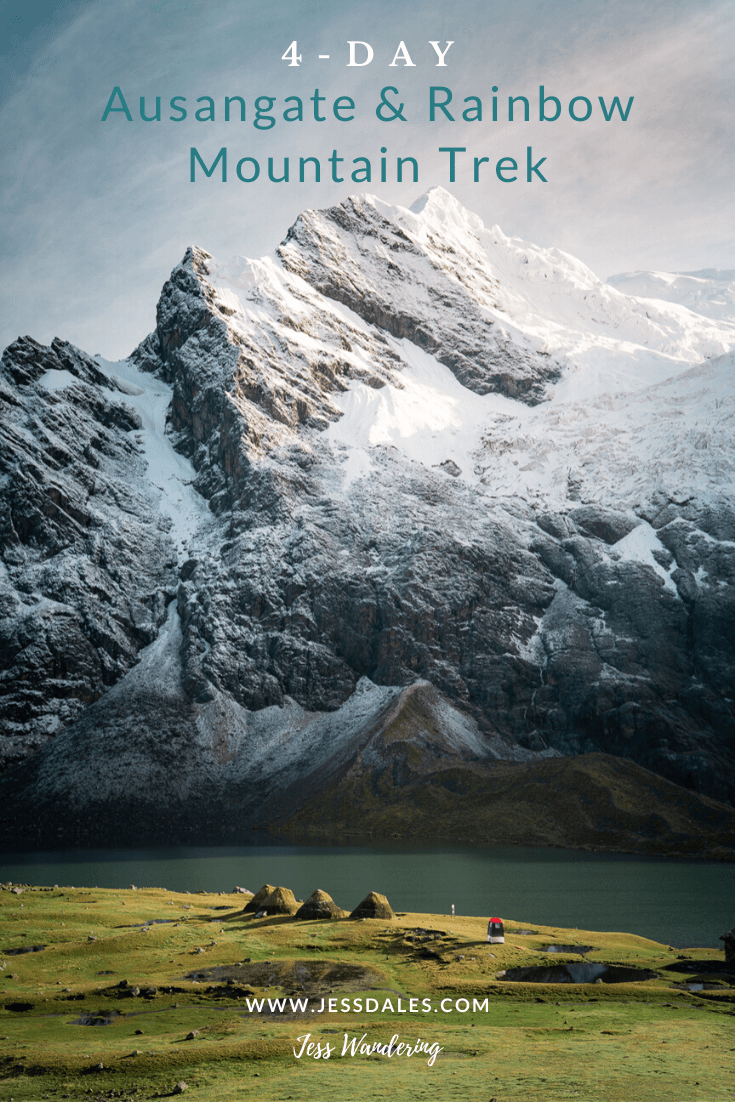
Photos taken in collaboration with Quin Schrock.
Trekking Peru’s Ausangate Trail
I flopped down on the ground gasping for air. It was the fourth day of our Ausangate Trek, and we had chosen to veer off the traditional loop itinerary to catch sunrise at Rainbow Mountain. Famed for its multicolored stripes, the view was currently obscured by a wall of thick grey fog. At just over 17,000 ft, Rainbow Mountain was the highest point on our 4-day trek, and I was feeling it. We had hiked to Rainbow Mountain in the dark, and now, as the fog drifted in and out, I caught my first peek-a-boo views of the surrounding landscape. In front of me, the first hints of rainbow-colored earth, behind me, the tip of Ausangate peeked over the pass we had hiked through the day before.
The Ausangate Trek is renowned for its otherworldly natural scenery. It’s considered by many to be one of the world’s best high-altitude treks. Recognized as sacred in Incan mythology, Ausangate features windswept valleys, snow-covered peaks, glaciers, panoramic views. . .
Basically an alpine wonderland.
But after a little bit of research, it became clear that the one thing the Ausangate circuit did not actually include was Rainbow Mountain.
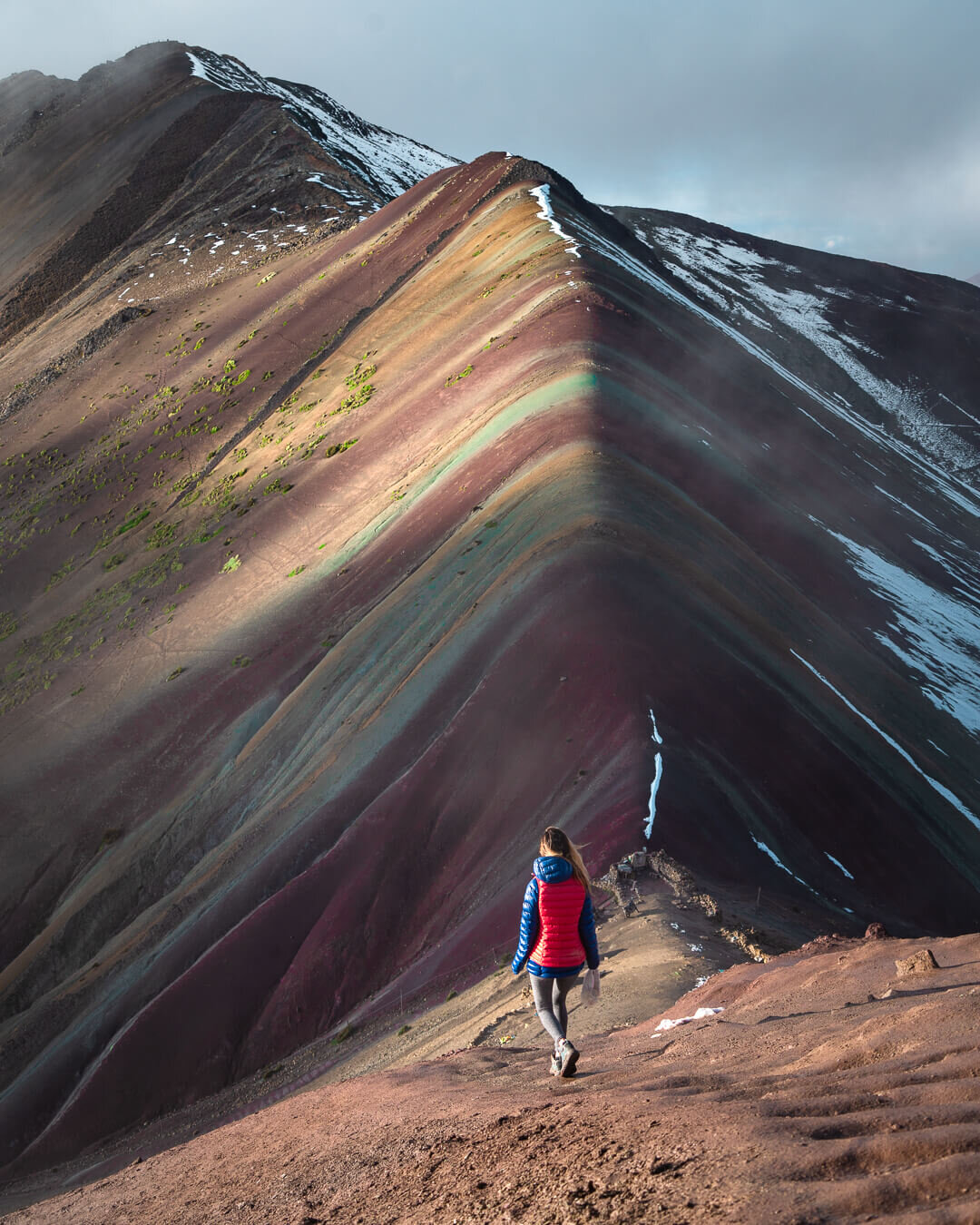
Rainbow Mountain hike at sunrise.
Traditionally, the trek starts at the beginning of the Vilcanota mountain range and then loops approximately 70km around Ausangate. The trek is generally done over 5 days and 4 nights of moderately strenuous hiking. But we didn’t take the traditional loop route. We simply didn’t have time. So after doing some research on the locations we wanted to photograph on the trek and talking with our guide at Killa Expeditions, we decided to do the first three days of the Ausangate Trek before heading to Rainbow Mountain and then hiking out. It was our hope that this truncated itinerary would give us the best bang for our buck on a tight timeline. As I sat on top of Rainbow Mountain basking in the early morning light, there wasn’t a doubt in my mind that we had made the right decision.

Our camp on the third night of the Ausangate Trek in Peru.
Do You Need A Guide For The Ausangate Trek?
After Quin and I did the Huayhuash a couple years back, everyone wanted to know if we used a guide or not. So I figured I’d spare you the suspense and tackle this question head-on for the Ausangate Circuit. Obviously, the answer depends a little on who you are, how much long-distance trekking experience you have, and how you handle high altitudes. But putting all those variables aside, here’s my advice:
Do you need a guide to complete Ausangate? No. Do you want a guide? YES!
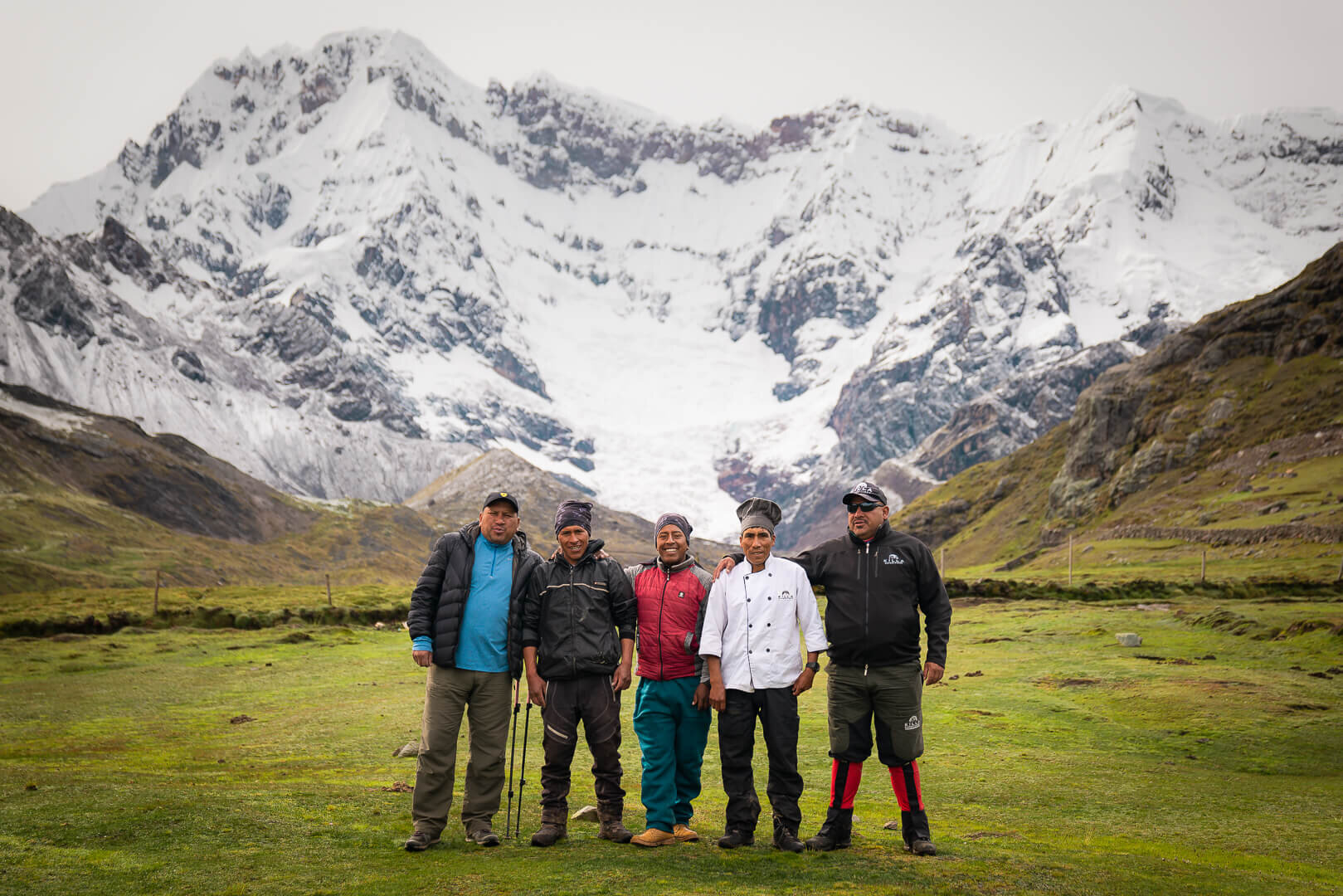
Our fabulous Killa Expedition family! Killa Expedition’s team is made up of knowledgeable, passionate and experienced local guides and staff, with a strong commitment to responsible travel.
Here are just a few of the many reasons I would suggest hiring a guide for the Ausangate Trek:
1. You Don’t Have To Worry About Route Finding: The trail was a lot clearer for Ausangate than it was for Huayhuash, but there were still grey areas. The entire region is used for grazing alpaca and other livestock. That means animal tracks are going this way and that way, zigzagging across the landscape. Yes, I know you could just use GPS to keep you on track. But technology will never replace a local’s intimate knowledge of the area. Plus, there’s something very freeing about not having to constantly worry if you’re going the right way.
2. You Don’t Have To Carry Overnight Gear: When we decided to complete the Ausangate Trek with Killa Expeditions, they provided us with a guide, a cook (more on that later), and two local horsemen. Every morning the horsemen would pack up our overnight gear and deliver it to the next basecamp where it would be waiting in our tent for us! That means that all day, every day, all we had to carry were our day packs. And that can make the difference between a real slog, and an enjoyable day in the mountains when you’re at high altitudes.
3. The Altitude Is No Joke: Altitude sickness is the real deal, and it can be dangerous. It generally occurs when you don’t give yourself adequate time to acclimate to the environment, the change in air pressure, and the lack of oxygen. This happens when you climb to high elevations too quickly. But the truth is, altitude sickness can happen even if you give yourself time to acclimatize. It can happen to anyone at any time. And I can pretty much guarantee you that if you are coming from most other places in the world, you are going to feel the altitude on this trek. Having a guide to help set an appropriate pace, make sure you’re taking adequate breaks, and transport most of your gear from camp to camp will make your battle with the altitude significantly easier.
4. The Food Is Delicious: Now I’m sure this specific bonus depends to some extent on the guide company you choose. For instance, the food that Killa Expeditions fed us on the Ausangate Trek was far yummier than the food we had on the Huayhuash Trek. Regardless, hot three-course dinners are always going to be better than the typical backpacking food that I would make myself.
5. It’s A Great Way To Support The Local Economy: Responsible travel doesn’t have to be complicated! Nor does it have to ruin all the fun. On the contrary, many of the tips I included in my recent post about How To Be A Responsible Traveler will enrich your travel experience by helping you connect deeper with your destination and the people that call it home. And one of the easiest ways you can travel more responsibly is to support the local economy! I’ll be the first to admit that my impulse when I backpack is to explore on my own.
But more recently, I’ve been making an effort to hire local guides like Killa Expeditions. Sure, it might be a little more expensive than doing the trek independently, but it’s a great way to ensure your contribution to the economy will have a more direct and positive impact on local communities.
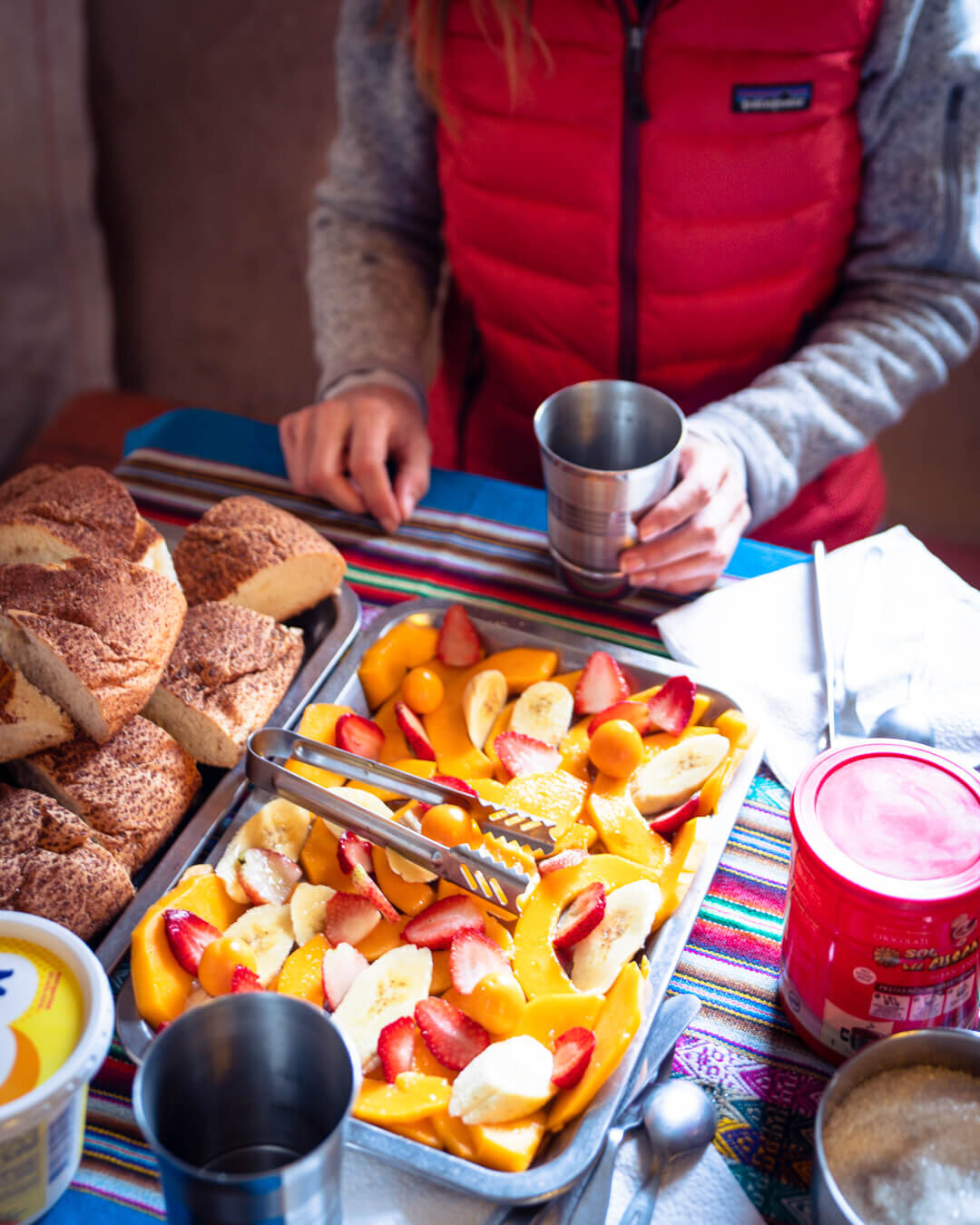
Typical breakfast on the Ausangate trail in Peru. And this was just the first course!
The Ausangate & Rainbow Mountain Trek Itinerary
At the beginning of this year, I decided that I wanted to keep a journal. Nothing to fancy, just something to keep track of my thoughts, trips, and to-dos. I completely failed! But, I did manage to keep one during the Ausangate Trek, and I think the entries from those four days are the best way to get a feel for what the trek is like.
DAY 1: Tinki 3,880 m (12,730 ft) – Upis (hot springs) 4,400 m (14,430 ft)
Killa Expeditions picked us up at our hotel in Cusco at 7:00am. Half asleep, we made the 3-hour drive to the small community of Tinki to start the trek. It was an easy first day. Mostly level. We hiked along a dirt road for most of the day that only locals are allowed to drive.
The weather was ominous from the beginning, and after about an hour of walking, our guide instructed us to put on the $4 ponchos we had purchased in Cusco the night before. Less than 2 minutes later, the sky opened up and hail showered down on us like angry bbs from heaven. I still don’t know how our guide nailed the poncho timing, but now I know we’re in good hands! It’s strangely comforting.
But even with the ponchos, we were getting slaughtered out in the open, so we made a break for the nearest shelter. The only refuge near us turned out to be a tiny farmhouse made from mud bricks and straw.
We huddled under the small overhanging eve and waited for the deluge to subside. It didn’t, so we surrendered to the weather gods and continued on.
In the 10 minutes since the hail started, it had turned the trail into a river of chocolate milk. Not the watered-down kind you find at home, but the thick unsweetened chocolate dulce de leche I might have savored back in Cusco. Eventually, we made it to Upis and our basecamp for the night.
When we arrived at the camp the horsemen (we were traveling with two) had already set up camp for us!
Our tent sat like a cherry on top of a picturesque knoll resting peacefully in the shadow of Ausangate.
Or at least that’s what we were told. As was typical of our luck so far in South America, the mountain was entirely shrouded by low lying clouds, leaving us with nothing but a blank white canvas to imagine what she might look like.
There’s a small hot spring at Upis, and we decided to walk over and check it out after lunch. On our way to the spring, we ran into a solo traveler from Holland. He was the only other person we had seen all day except for our guides and horsemen, and it didn’t take much convincing to get him to join us at the hot springs. Unfortunately, when we arrived, the cement pool that I can only assume normally functions as a giant hot tub was empty, and only a few sad inches of water remained at the bottom.
Cold, and with nothing else to do, we decided to climb down the usually submerged stairs to the bottom of the tub. Taking off our boots and soaking our feet in the warm water, we made the best of it. And I have to admit, there are far worse things than a hot foot bath with an interesting stranger after a long, wet day of trekking.

Base camp at Upis on the Ausangate Trail.
DAY 2: Upis (hot springs) 4,400 m (14,430 ft) – Pucacocha 4,500 m (14,760 ft)
We woke up to hot cocoa tea and clear skies this morning. Ausangate loomed over our tent, its snow-capped peaks piercing the white sky. After breakfast, we left Upis and headed up Arapa Pass. It was the first real elevation gain of the trek. The views unfolded and expanded as we climbed. At the pass, we stopped to snack on sour Mike & Ikes and apples. Why does candy taste sooo good in the mountains?

Mountain views on the second day of the Ausangate Trek in Peru.
The views at the pass stretched out above and below us in every direction. After the hail storm and low visibility yesterday, it was a much-needed morale booster. The rest of the trail to our second camp followed suit, and the 12km passed quickly. We arrived early in the afternoon with plenty of time for taking photos, reading, and lounging around. Ausangate is considered one of the harder treks in the Cusco area, but I think the real challenge is just adjusting to the elevation. So far, it doesn’t feel nearly as difficult as Huayhuash.
Camp was meant to be down in the flats next to the lakes at Pacacocha. But due to heavy rains, the flatlands were saturated, and we were forced to set up camp on higher ground.
The impromptu basecamp is a blessing in disguise.
The views from this higher vantage point are mesmerizing, plus we were able to find shelter for our tent in a small grass-thatched A-frame.
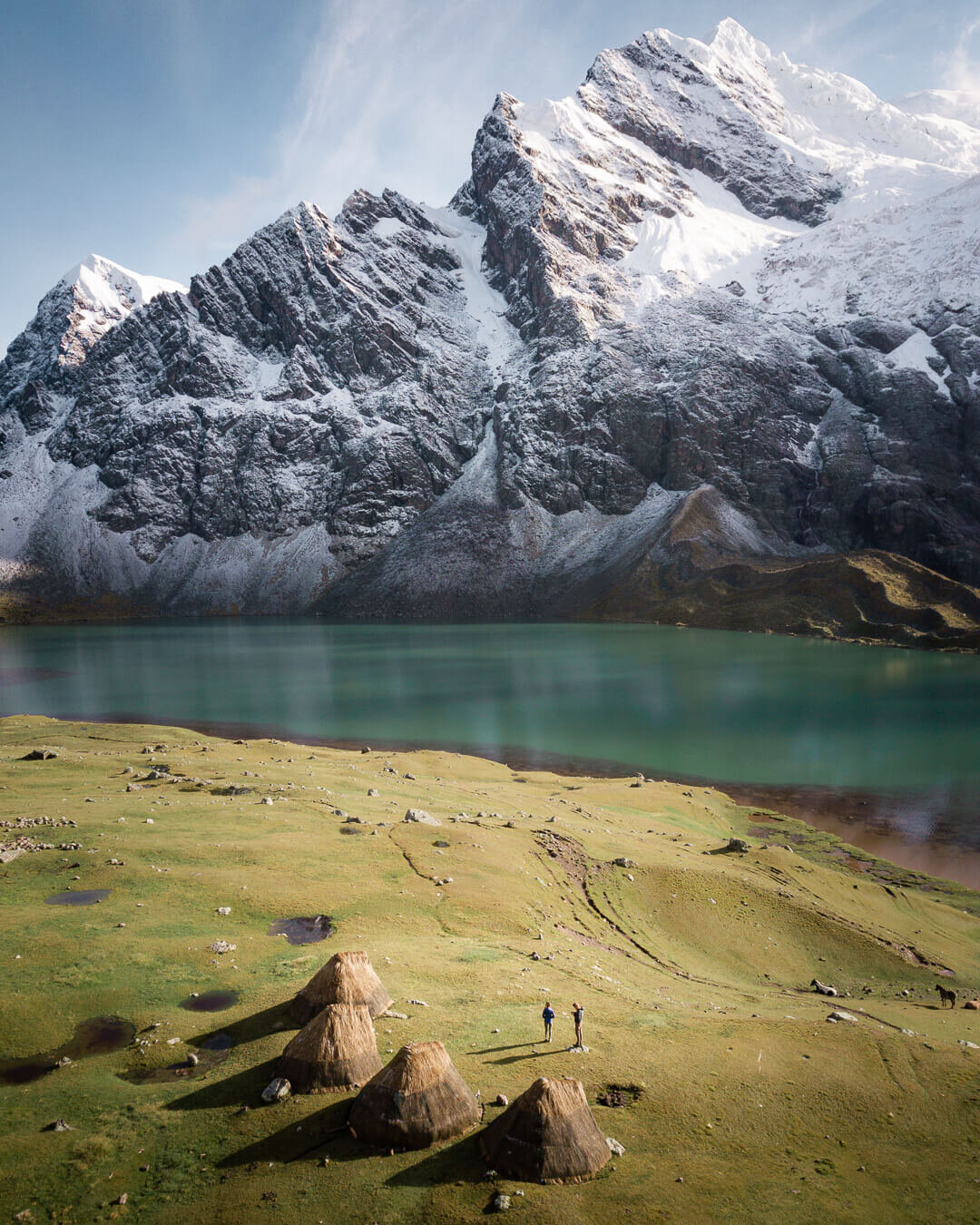
Views of Ausangate from our camp.
The occasional thundering sound of the glacier calving on Ausangate in the distance is a stark reminder of how quickly these landscapes are changing. . . melting. . . breaking. Then again, there’s something timeless about this place. We are walking along Inca trails so old that even the locals can’t remember why or how they came to be here. The people who call these mountains home still live off the land, isolated from the outside world.
Their lives pass in much the same way as their ancestors did. It’s difficult for me to wrap my head around what it would be like to exist out here. Miles away from your closest neighbor. No electricity. No technology to keep you tethered to the defining noise of modern life. I bet it’s a happy existence. . . or at least a content one.
I wonder if they watch tourists pass through these mountains day after day, snapping our pictures, logging our miles, checking off bucket lists, and wonder why? Is life really better lived quickly? I doubt it.
The natural conflict between change and timelessness is palpable on these ancient trails. I can’t help but wonder what it will look like when the two forces inevitably collide. Or maybe that’s what I’m already looking at.
DAY 3: Pucacocha 4,500 m (14,760 ft) – Suricocha 4,600 m (15,170 ft)
Today was the type of day in the mountains that we dream about waking up to. It’s not often that conditions align with a location perfectly, and this morning was one of those special occasions. It rained all last night, and even when we had first arrived at the camp, most of the mountain had been covered in clouds. But not this morning. This morning was glorious! Blue skies, with wispy clouds framing Ausangate. The mountain itself glowed in the early morning light, and two perfect alpine gems glittered at her base.
The third day of the Ausangate Trek has arguably the most extraordinary views, so the timing could not have been better. We hung around camp a little longer than planned, taking photos with that frenetic energy that happens when everything is perfect, but you’ve got places to be and miles to cover. After breakfast, we began to climb up Puka Pass (16,370 ft), the first of two passes for the day. All the rain the night before had flooded the trail and created small tarns that dotted the landscape, creating small reflection pools everywhere we looked.
The effect was stunning.
At the right angle, Ausangate’s brilliant reflection bounced off the surface of the water as if to assure us that it was indeed the fairest of them all.

Heavy rains the night before created beautiful reflection puddles along the route on the Ausangate Trek in Peru.
At the pass, we basked in the sun for a while before starting the long descent down into the next valley. I’m not sure what the valley was called, but it was home to hundreds of Alpacas of all shapes and sizes. Something about them just makes me smile. Quin ran around trying to get a photo of them – I think he’s even more smitten than I am – while the rest of us ate lunch outside an Andean Lodge.
Halfway through lunch, we heard the first crack of thunder in the distance, and I knew by now that it wouldn’t be long before the rains started again. There was a clear pattern at this point. Every morning was bright with promise, and every afternoon was a race to beat the inevitable evening downpour. All things considered, if it had to rain, it was a pretty ideal setup – as long as we made it to camp before the rains did.
Our luck ran out today. Halfway up our second pass (Warmisaya, 14,370ft), the sky turned black, and the hail quickly followed. There was no shelter this time. No eve to hide under. So we booked it to camp just in time to enjoy some hot soup, tea, and popcorn.
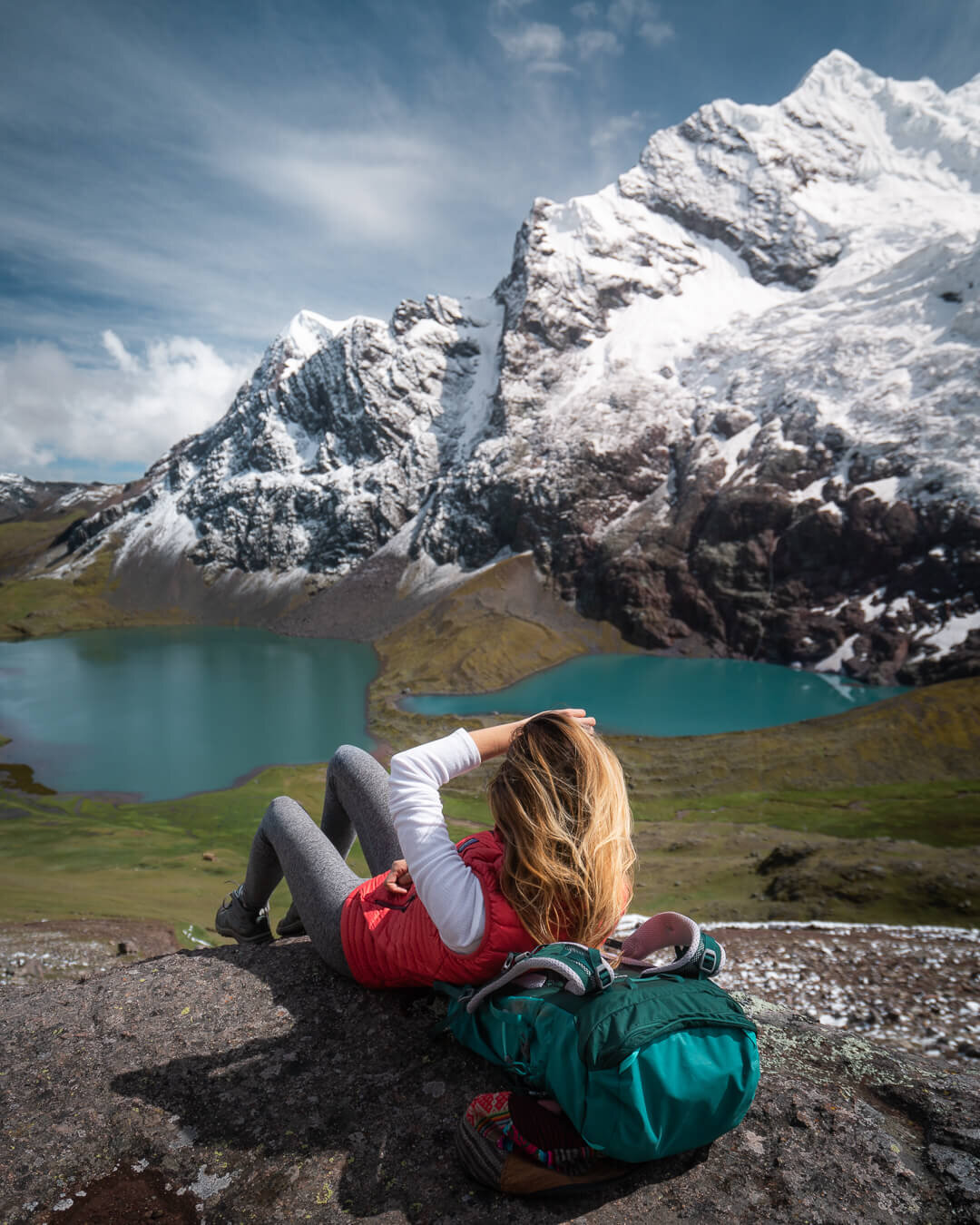
Stopping to take a break on the way up to Puka Pass on the third day of our Ausangate Trek.
DAY 4: Suricocha 4,600 m (15,170 ft) – Rainbow Mountain 5,050 m (16,568 ft)
I can barely remember this morning. It feels so long ago. We woke up at 4am so that we could make it to Rainbow Mountain for sunrise. The hike was actually pretty short. Maybe an hour and a half at most, and only a small portion of that was uphill. We didn’t quite make it for sunrise, but it didn’t matter. There wasn’t one anyway. When we got to the top of the viewpoint, a thick wall of fog was waiting for us. That, and our cook with hot cups of cocoa. I still don’t know how he beat us up there. But it was freezing, and nothing has ever tasted so good.
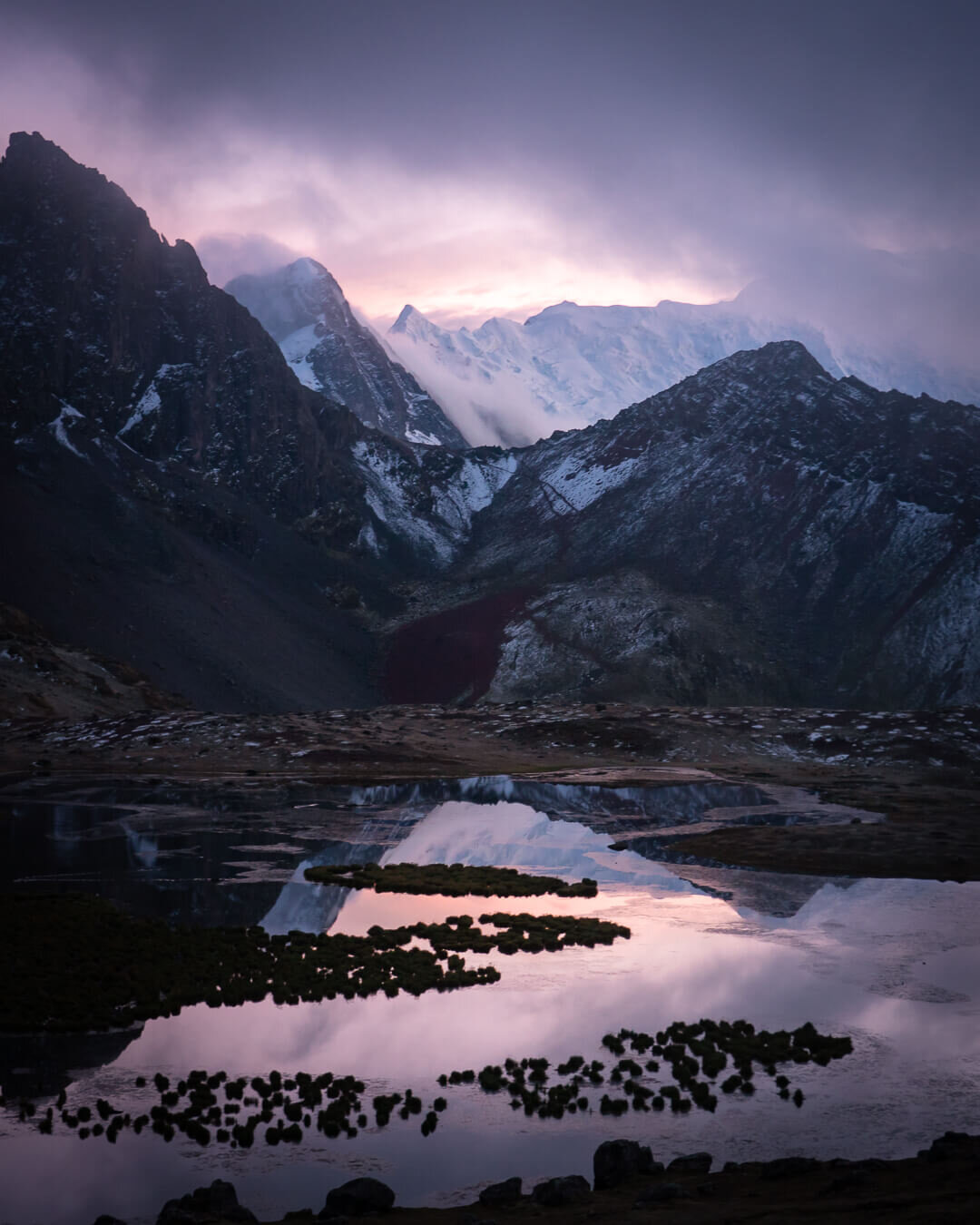
Sunrise on the way to Rainbow Mountain the 4th day of the Ausangate Trek.
There was another reason for leaving camp so early – other than just trying to catch the sunrise. We also wanted to avoid the crowds that would apparently descend on Rainbow Mountain come mid-day. After days of not seeing anyone outside our little crew, it seemed incomprehensible that this spot that had taken us 4 days of trekking to get to would be flooded by hundreds of selfie-taking visitors in a few hours.
But our guide assured us it was true. While we waited for the fog to lift, he told us about the ever-expanding network of roads that were being cut into the landscape to make this popular site more accessible.
Each little community in a battle to claim the closest access to the colorful mountain.
What once could only be reached after days of trekking was now a popular day trip from Cusco, with buses scooping people up and then depositing them at the end of whichever road had managed to sneak its way furthest up the mountain pass.
Eventually, the fog did lift. Rainbow Mountain was everything I had thought it would be – but nothing more. Perhaps I’ve just seen too many pictures of it. Or maybe the untouched beauty of the preceding days overshadowed it in some ways. Or maybe the fact that you can practically drive up to it now somehow detracted from its appeal for me. Don’t get me wrong, it’s a cool natural phenomenon, and fun to photograph, but I sure am glad that we got to experience everything that came before it as well!
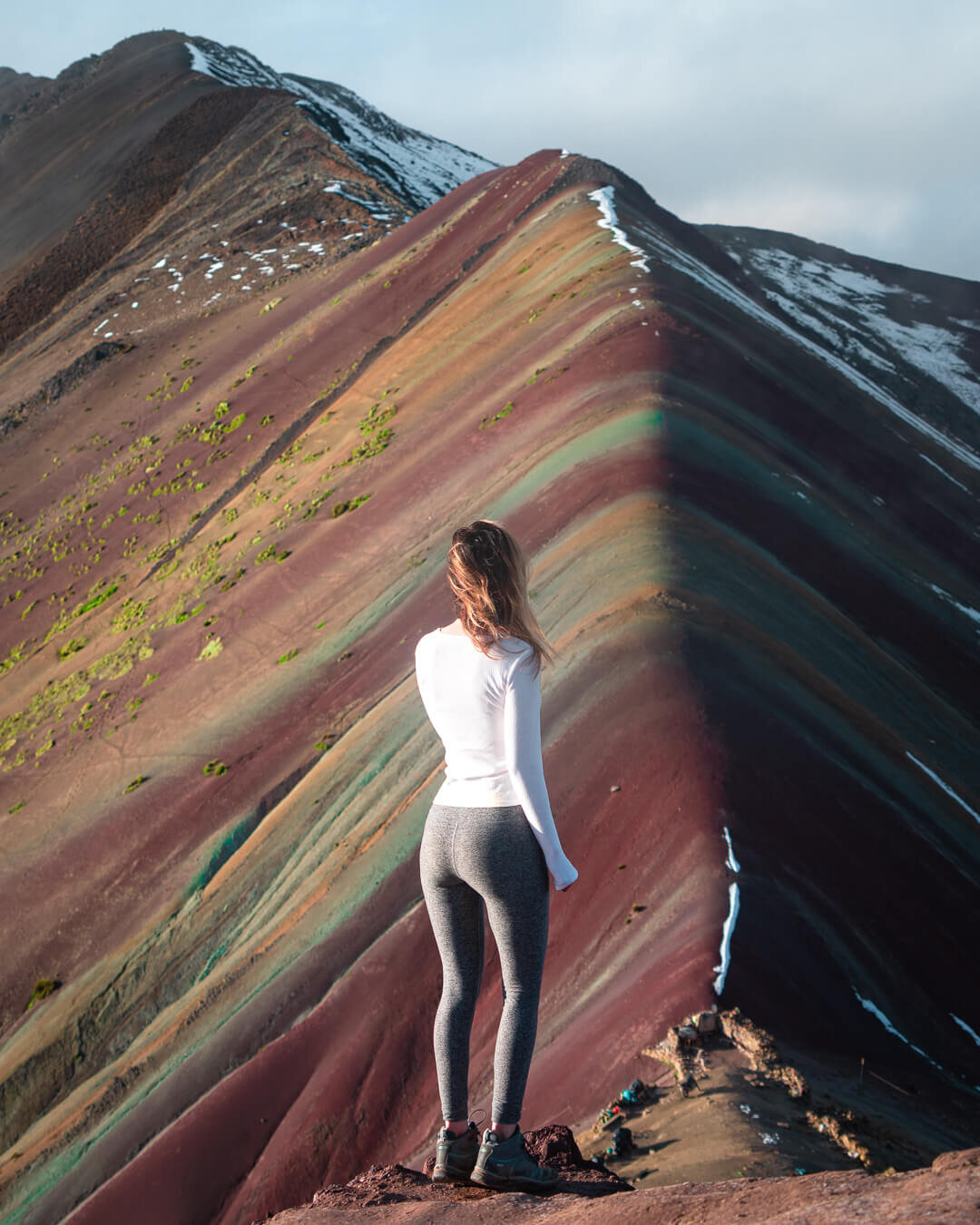
Rainbow Mountain in the morning after the fog cleared.
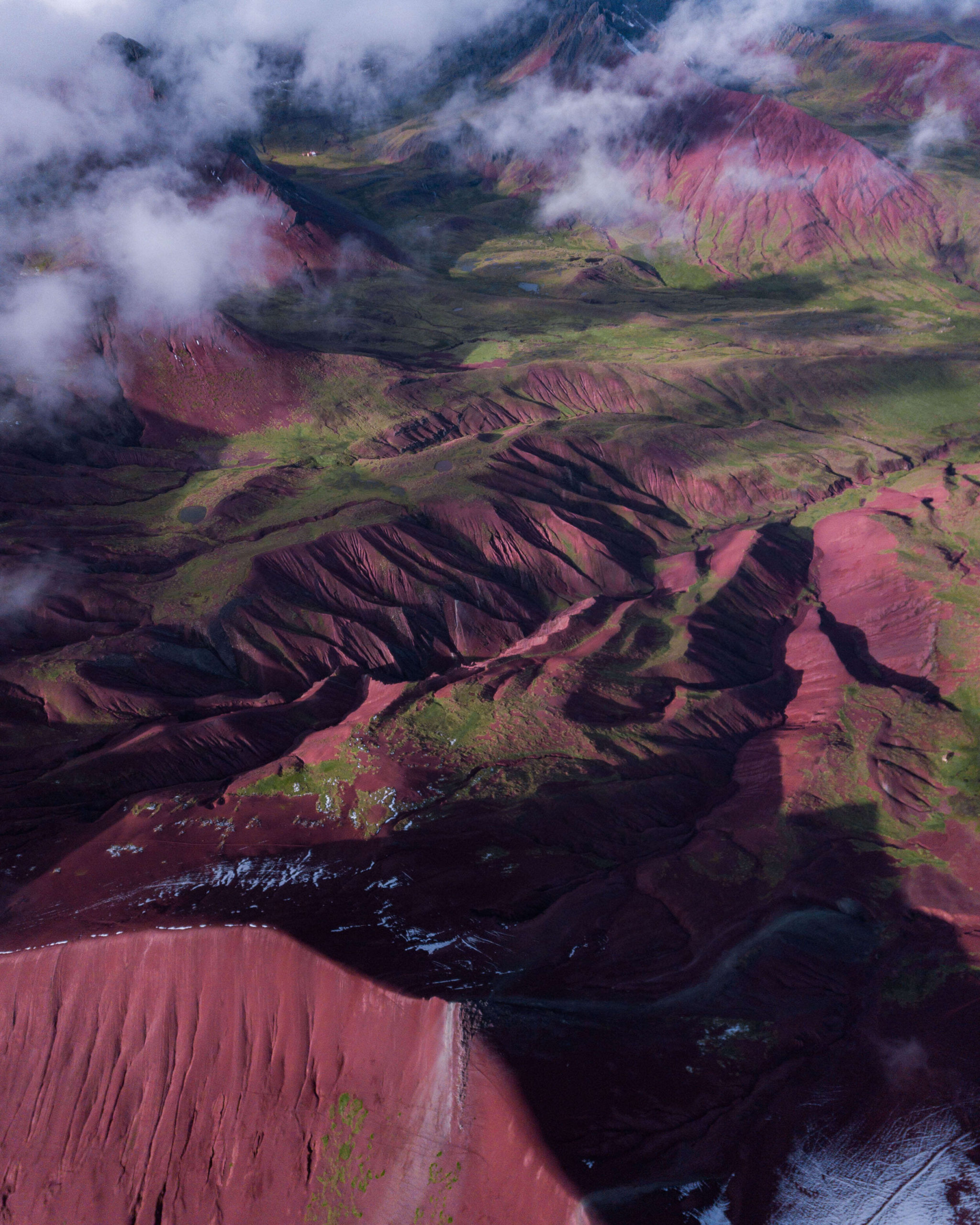
The vivid red colored earth that Rainbow Mountain in Peru is famous. for.
What To Pack For The Ausangate Trek
It’s always important to think in terms of layers when you head into the mountains, but this is particularly true at high altitudes when you never know what you’re going to get! During our trek, we had some combination of sun, rain, and hail, every single day. Granted, we did the trek in March (which is technically the wet season), but regardless of when you hike, I’d be prepared for potentially cold wet days and freezing nights. With that in mind, here is a complete packing list for the Ausangate Trek.
DON’T FORGET! You should always carry The TEN ESSENTIALS for outdoor adventure with you. They might just save your life!
Storage
If you are going with a guided hike like we did you will only need to carry a day pack, everything else will be stored and carried by pack animals.
BACKPACK: Osprey Tempest 22 Pack for women and the Osprey Talon 22 for men. My go to when I need a little more space without sacrificing comfort. It carries beautifully, cinches in close, and has enough pockets to keep everything organized without feeling fussy.
RUNNING VEST: I’ve started using a running vest for hikes when I don’t need much gear because it keeps everything light, close, and easy to grab without taking off my pack. The Salomon Active Skin 8 has become my favorite because it fits like a hug, carries water up front, and has just enough space for the basics without ever feeling bulky.
Clothing
SUN SHIRT – The Crater Lake Hoody is my favorite sun shirt because it’s so light and soft it almost feels like air. It offers full UPF 50+ protection for long days in exposed terrain, so I don’t have to carry buckets of sunscreen.
SHORTS – You don’t need to reinvent the wheel here. Whatever works for you! I’ve been really enjoying the Lululemon Pace Rival High Rise Shorts and Outdoor Voices Warmup 5” Shorts.
HIKING PANTS – To be honest I’ve never been a big hiking pants person. I generally just wear one of my favorite pairs of leggings, because that’s what I’m most comfortable in. But this summer I picked up a pair of REI Trailmade Pants and they were nice! The Trailmade Pants are affordable, durable, and surprisingly versatile for hiking and backpacking. And I have to admit it was nice to have a pair of pants that were a bit more airy than leggings.
INSULATED LAYER (Down Jacket) – The Patagonia Fitz Roy Down Jacket is a cold-weather essential I bring on alpine or winter trips when serious warmth is non-negotiable. It’s stuffed with premium 800-fill down, so it’s incredibly warm for its weight. I’d recommend sizing down. But when I’m really trying to go lighter without sacrificing warmth it’s hard to beat Rab’s Mythic G Down Jacket. Best to pick this one up on sale if you can!
RAIN JACKET: The Rab Phantom Jacket is an ultralight, fully waterproof shell that packs down small and disappears in your bag until you need it. I’m a fair weather hiker, but in the mountains weather can change fast, so it’s great to have rain protection that doesn’t weigh me down.
Shoes
TRAIL RUNNERS – The Hoka Challenger Trail Running Shoes is my go-to shoe for warm weather hiking. I prefer trail runners over hiking boots because they’re lighter, more breathable, and dry quickly. I’ve worn mine on everything from day hikes to multi-day trips like the John Muir Trail, and they’ve been incredibly durable for how lightweight they are.
BOOTS – The Danner Inquire Chukka Mid is my favorite hiking boot! I wear it when I want more ankle support than a trail runner but still need something light and flexible. Or when I just want to look cute!
Hiking Gear Essentials
WATER PURIFIER – The Katadyn BeFree is my favorite filter for speed and simplicity. It’s ultralight, easy to squeeze, and perfect for quickly filling bottles on the go.
The Grayl Water Filter is much heavier but unbeatable for international travel or areas with questionable water sources because it removes viruses as well as bacteria and protozoa. It works like a French press—fill, press, and drink—with no need for extra bottles or gear.
HEADLAMP – Nitecore NU25 400 Lumen Rechargeable Headlamp
GPS COMMUNICATION – I carry the Garmin InReach Messenger Plus for peace of mind on backcountry trips — it lets me send texts and share my location even when there’s no service. The battery lasts for days, and it’s a small, reliable way to stay connected and safe when I’m off the grid. AND you can send photos and voice notes! Watch the video I made about the Garmin Messenger Plus! It’s one of my favorites.
** Garmin also recently released the new inReach Mini 3 with photo and voice messaging capabilities. So you’ve got lots of good options!
SMART WATCH – I’ve been wearing the Garmin Fenix Watch to track my activity for years. Plus it’s so fun reviewing and sharing hike details after!
TREKKING POLES – Durston Iceline Trekking Poles. I just picked up the Durston Iceline Trekking Poles because I wanted something ultralight but sturdy to take pressure off my knees on big hikes. They’re incredibly light (under 10 oz per pair) and I couldn’t be happier with them.
MULTI-TOOL – Swiss Army Classic Knife
FIRST AID – Band-Aids, Leukotape, pain relievers, and antibacterial cream.
POWER BANK – Nitecore Power Bank
Camera
SONY RX100 VII – The Sony RX100 VII is my favorite compact camera for backpacking because it’s small enough to slip in a pocket but still delivers professional-quality photos. The 24–200mm zoom range makes it incredibly versatile, and it’s the perfect option when I don’t want to carry one of my heavier cameras but still care about image quality.
| Just a quick heads up. Some of the links in this post are affiliate links, which means I might earn a tiny commission if you decide to make a purchase. It does not cost you anything, but it’s one of the simplest and most supportive ways to help me keep creating these guides. I’m not paid to recommend anything, and every opinion here comes from real experience with gear I actually use and love. If you’re planning on picking something up, using my link truly makes a difference and I appreciate it more than you know. |
For more gear check out my complete Hiking & Camping Gear Guide! It’s chock full of tried and true gear that has passed the test of time. Please note that there might be some affiliate links in this post. If you do choose to purchase something, I may earn a small commission – at no additional cost to you. As always, all ideas and opinions expressed in this post are entirely my own.
Happy adventuring! I appreciate your support!
– jess
MORE EPIC TREKS YOU MIGHT LIKE!
Trekking Peru’s Cordillera Huayhuash
The Kalalau Trail – To The Beach & Back
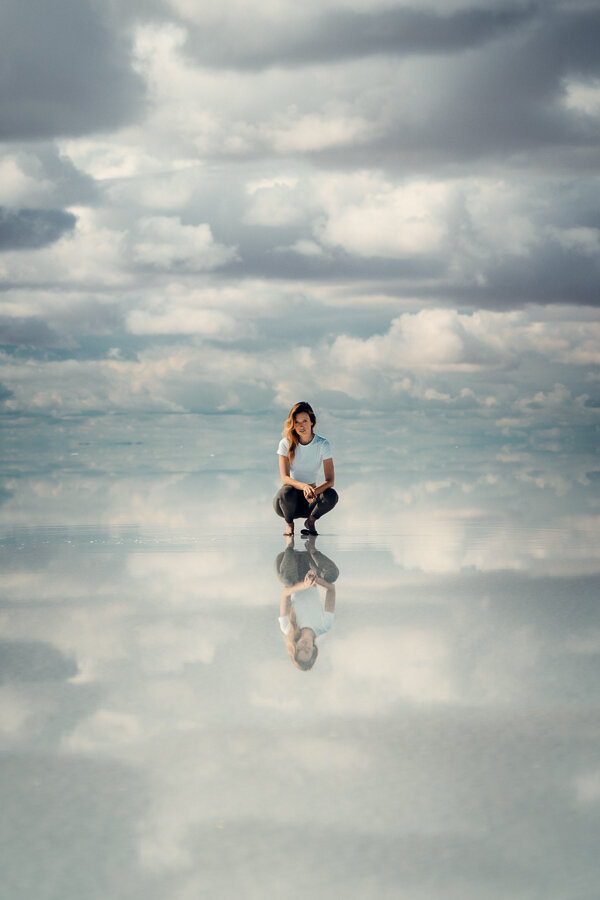
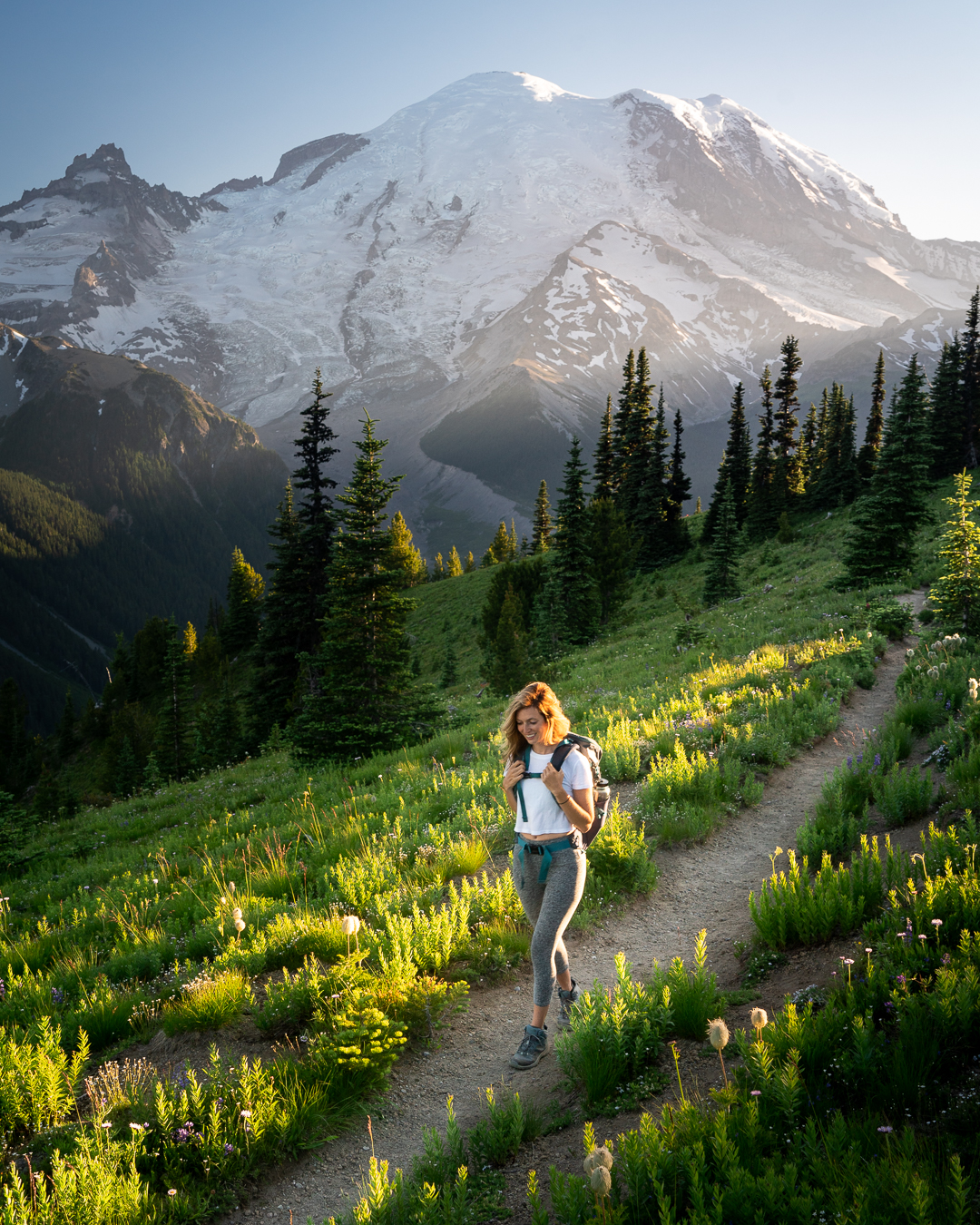
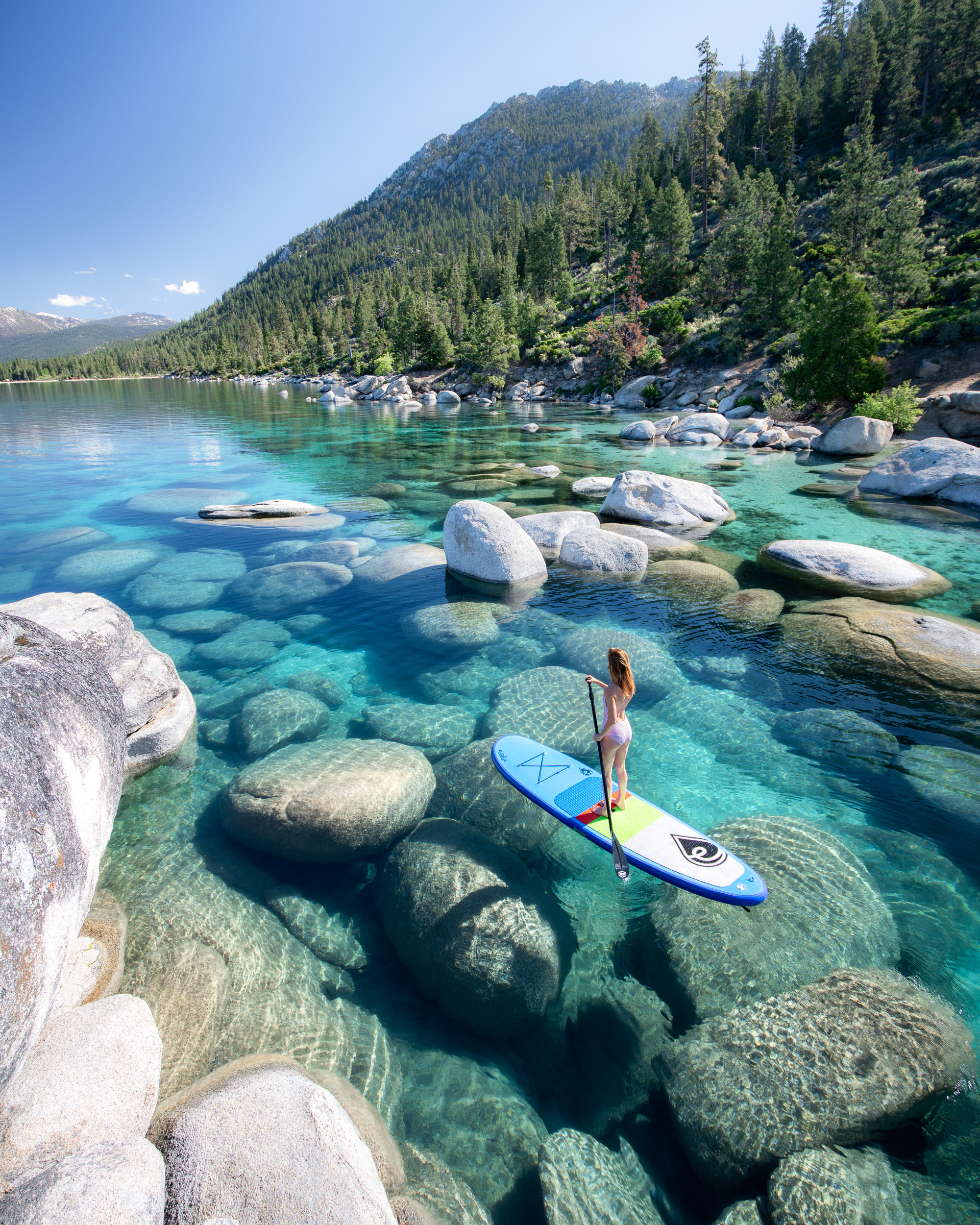
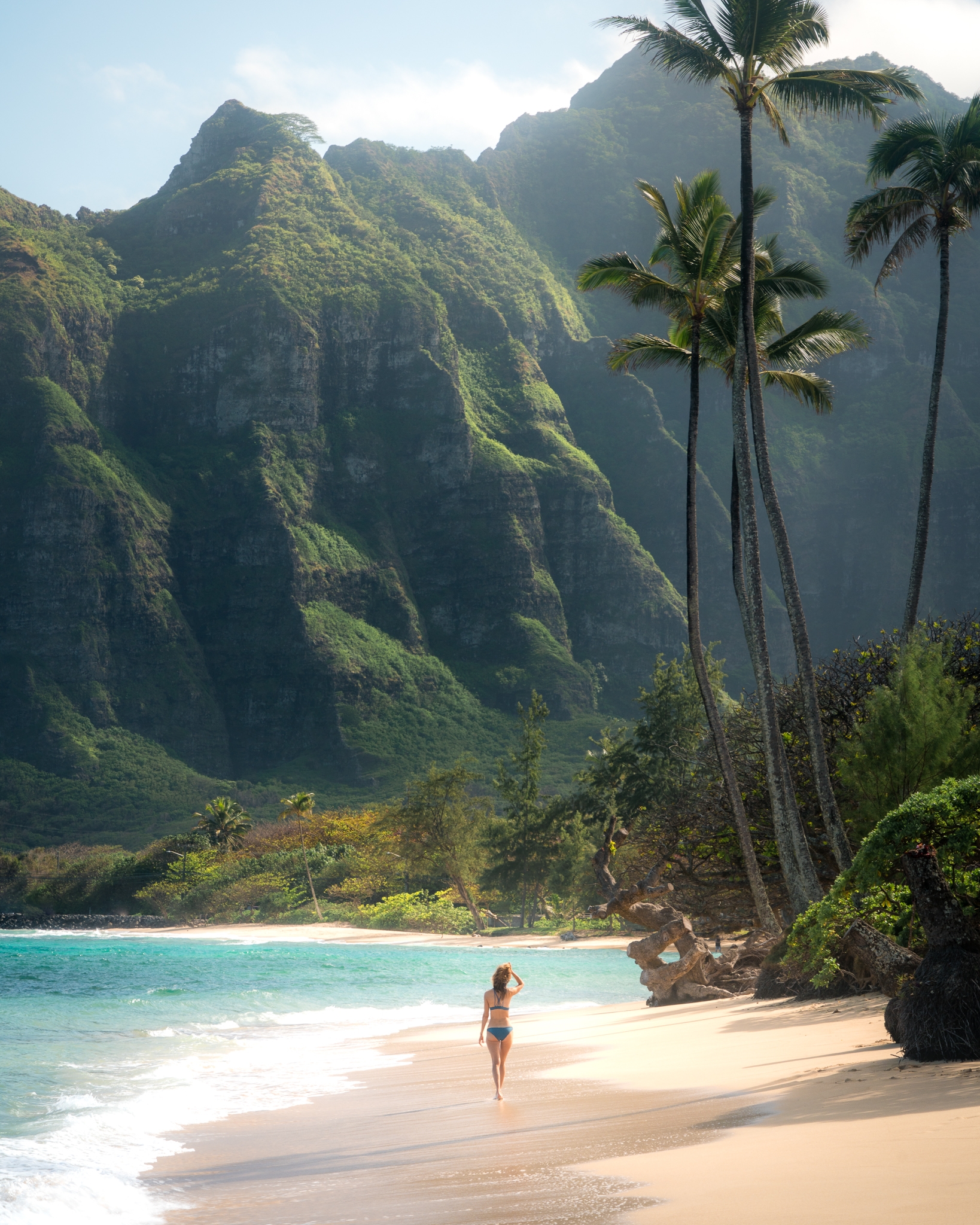
Thanks for all this Jess! Wow, nicely written voice, and I’m really grateful for this.
Thanks so much Jamie! It was a truly amazing experience, and I’m happy to hear it translated.
This experience looks amazing Jess! Thanks for sharing all the tips and your personal experience, it’s just so nice to read! I did the Salkantay Trek on 2018 and this post reminded me of my own experience, it was unforgettable!
PS: "…but the thick unsweetened chocolate dulce de leche I might have savored back in Cusco" This line made me laugh! I love dulce de leche, and I also saw your IG stories on how brown the water was!
Thanks so much Marcela! I would love to go back and to Salkantay someday. It was closed while we were there due to landslides. I really need to visit Peru during the dry season some day. lol. Hope you are staying safe out there! Xo
What a fabulous trek and incredible photography and views. You really were at the top of the world. Happy your home safe plotting your next adventure when the world re-opens! Keep you blogs coming they are wonderful!
Thank you so much! It seems like I’m going to have some time at home to write – so that’s the plan. Really appreciate your continued support. 🙂
We did the Salkantay Trek to Machu Picchu (with the amazing Salkantay Trekking company) and it was also amazing! I 100% agree that hiring a guide is the best option in the area for all the reasons you listed. Also if the trail gets washed out, the guides will know and put you on an alternate safe route. Solo trekkers have died on the salkantay trek from not knowing that!
Hi Sarah! Yes, that is another excellent reason to hire a guide. Our guide was actually telling us about people getting lost and dying on Salkantay. We had very rainy conditions, and there were a few place where the trail was under water, so I can totally see that becoming an issue.
Ken…I totally agree on your comment, "do you need a guide..no, do you want a guide….yes!!! I agree with all the reasons as well as how enjoyable it is to get to know the local people and learn about some of their customs.
As usual photos are just totally………..awesome
Glad to hear you’re on the same page Ken! And I completely agree. Our guide was such a wonderful source of information about the trail and the local communities.
Wonderful blog and post .. what’s the cost of the trek ?
Hi! Killa Expeditions offers a wide variety of different tours. The best place to find updated prices is on their website. I’ve linked it above, in the blog article, if you want to check it out!
My daughter and I had a nearly identical trip to Peru planned the last 2 weeks of March, to celebrate her 21st Bday. Sadly we had to cancel but on the bright side I’m going to use some of your guidance and product recommendations to plan for it in the Fall or Winter. I love following you and Quin, your photos and writing are inspirational! Stay healthy! Linz
I’m so sorry to hear that you had to cancel your trip. What wonderful mother daughter adventure. I’m glad to hear that you are still planning on doing it! Peru is such a beautiful country, you two will have a blast once you’re there. Let me know if you have any gear questions!
Sounds like it was an awesome experience! Great insight. My GF did the Peace Corps down in Peru, and I hope that I get to see what her world was like down there, and try to accomplish a similar adventure to what you were able to do!
Hi Chase! That sounds like an awesome plan. I’m sure my experience was a lot different from anything someone in the Peace Corps would be exposed to, but I have to say Peru is one of my favorite countries. I hope you get the chance to check it out for yourself!
Great write-up Jess – very inspirational. I look forward to visiting Peru some day!
Thanks so much Lisa! Peru is one of my favorite countries. I hope you enjoy it when you go! 🙂
Stunning photos as usual!! Thank you for sharing Jess 🙂
Maybe you can do this one when you visit Peru!
Hi Jess,
Such a good blog on your experience, we thoroughly enjoyed reading it, and beautiful pictures as always! We were due to be in Peru over April, hiking Huayhuash amongst others. Ausengate didn’t fit into our VERY tight itinerary, however since reading your experience we may have to re think that…once we get back out. The Peru dream may be on hold but it’s so nice to read posts like yours to help keep the excitement alive.
Thanks so much 🙂
Beck & Dan
(travelmademedoit.com)
Thank you so much you two! I’m glad that this post could keep fueling your Peru dreams while we are all on hold for a little while. Ausengate was a great trek, and we really enjoyed our experience. But I agree, there’s just never enough time in Peru!
Hi Jess,
Wanted to thank you a bunch for this blogpost. My husband and I were completely mesmerized by your journey and the landscapes in Ausangate that you talk about and decided to venture on this trek with Killa Expeditions. Killa, from day one has been exceptional with communications and answering our questions plus their team(Franklin, Nayra, Daniel and everyone else) in Peru went above and beyond with helping us with our needs.
The trek itself was fantastic and the landscapes were unreal! We absolutely lucked out with the weather and acclimatization in Cusco definitely helped. We were partnered with another couple who were also on the same trek with us, after having heard about it from you! Together, we had such fun and the 4 days went by like a breeze. You and Quin rock! Hoping for many more adventures inspired by you guys!
Hi Surabhi! I am so sorry that I did not respond sooner to your lovely message. I have to tell you that when I first received it, it absolutely made my day. I’m never quite sure if people actually read/use the blog and so much work goes into it, that it really is so rewarding to hear that someone went out and made some great memories based on something they read here. So thank you so much for letting me know! Also, I can’t believe that the other couple with you had also read the post. How AMAZING. 🙂
Hi! First off I love reading your posts. I’d love to do a few trips like this but it’s just me. Is this something you would recommend doing solo? Were the others with you in your group besides the guide or just you two? I’m a travel nurse and used to exploring new places on my own. I’ve just never done overnight camping or gone out of the country alone. I’m nervous being female and in my mid 20s but I don’t want to miss out on such an amazing experience.
Hi Natalie! I think that doing one of these guided hikes as a solo traveler would be a great option. When we did the trip it was just us and the guide because we specifically requested a private tour. When possible we do private tours because we often go a lot slower and have different priorities because of all the photos we want to take. But I have also done tracking tours in larger groups and that was a lot of fun too!
Hi Jess! I’ve been following you on instagram for so long. This is one of the most informative blogs I’ve ever stumbled across while planning a trip. I was trying to do something similar since I also have a tighter schedule. Do you mind me asking what was the list of photograph spots you provided to your guide? I’d like to provide the same to ours as well. Thanks!
Hi Sophia. Unfortunately I don’t have the list anymore. It was honestly more just a collection of photograph, not destination names. We saw all of the places we wanted to see on this trek though, so if you just do this itinerary, then you will see all these locations.
Thanks for sharing your experience, Jess. A few thoughts to further inform readers: The Ausangate Trek has otherworldly beauty; frankly, far far better than the Salkantay Trek, for those who have to decide between the two (I saw that a few commenters have mentioned the Salkantay Trek). Another suggestion (this one in direct contrast to what Jess did): Take a car from Tinki to Upis; might cost 100 soles–which seems expensive given that a 4-hour bus trip from Cusco to Tinki is only 10 soles–but the otherworldly beauty doesn’t start until an hour or so past Upis, and that road is nothing more than a badly maintained dirt road. If not making the full circuit (most people will find the West and South sides of the Ausangate landscape–the parts Jess and Quin did–more beautiful than the East and North sides), that extra day could be dropped or spent taking a longer and more beautiful roundabout route to Rainbow Mountain and Red Valley on the south side of Ausangate.
Thanks so much for your input Jason! Always love when readers share insight from their own personal experiences. I’m sure that it will help someone who is planning their trip and wants to look into alternative routes/options. It’s such a beautiful area, you really can’t go wrong!
Ausangate is a great hiking route for adventurous people, you can do it without a guide and without an agency, thanks to the technology and maps found online it is very difficult to get lost. Of course, it is always advisable to go with a group of friends or family. I was there a month ago, there was still some rain, the cold is intense at night and during the early morning, but during the day the sun is strong. I went with a friend, we contacted a travel agency that a friend had recommended to us, Inca Peru Travel, direct operators with good prices and also have high-quality camping equipment and the necessary staff to carry out this journey (guides, cook, muleteers ). Well, we did the Ausangate + Rainbow Mountain in 5 days.
Amazing write up, thank you so much. If you could only pick one, would you do the cordillera huayhuash trek or the ausangate? I will prob only visit one region of peru in my lifetime and struggling to decide which.
I think Huayhuash is probably the more impressive trek. But Ausangate is near Cusco, so you could probably see more if you did that one. It’s a hard call!
Hi Jess! Your photos are breathtaking. I did have a question that you could maybe help me with… If I‘lol be doing both the Huyhuash and the Salkantay, would you recommend also doing the Ausangate? I have a flexible week in September and was considering either staying longer in the Sacred Valley or visiting the Valle de los Volcanes near Arequipa and cannot make up my mind. Thank you!
I Rachelle, what an exiting trip! I haven’t personally done the Salkantay Trek, so it’s a bit difficult for me to give advice on this. I really did love the Ausangate Trek, especially ending at rainbow mountain for sunrise before anyone else arrived. But I’m sure that you will enjoy whatever you choose to do. Peru is such a beautiful country.
Hola Jess!
My husband and I are doing this exact hike this coming March – I have a few questions though: 1) would you suggest taking Diamox (altitude sickness pills) for Ausangate? 2) is this a super hard hike? We keep getting mixed reviews. Some say the hike itself isn’t that strenuous, it’s just the altitude part that makes everything hard. Or is it just all hard? 3) what were the top items you’d bring for the wet season? Gaiters? Waterproof hat? And 4) what camera did you use for this hike? Did filters make a difference with the sun and altitude? Thank you for this blog, it’s wonderful and super helpful!